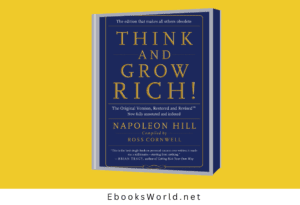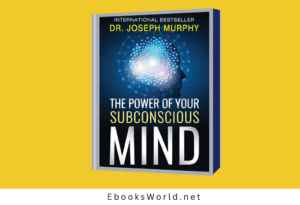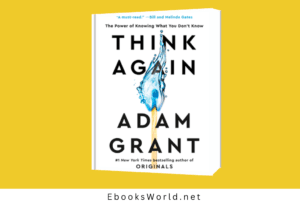Rich Dad Poor Dad

“Rich Dad Poor Dad” by Robert T. Kiyosaki is a personal finance classic that offers valuable insights into financial literacy and mindset. The book is written in the form of a memoir and revolves around the author’s experiences growing up with two influential father figures, his biological “Poor Dad” and his best friend’s “Rich Dad.” Here’s a summary of the key concepts presented in the book:
1. The Importance of Financial Education: The book emphasizes the significance of financial education, arguing that traditional schooling often neglects practical lessons about money and investing. Kiyosaki believes that understanding how money works is essential for achieving financial success.
2. Assets vs. Liabilities: Kiyosaki introduces the concept of assets and liabilities. He suggests that building wealth involves acquiring income-generating assets (e.g., real estate, stocks, businesses) that put money in your pocket, while minimizing liabilities (expenses that take money out of your pocket).
3. The Rat Race: Kiyosaki criticizes the “rat race,” where individuals work hard to earn money to cover expenses and liabilities. He advocates breaking free from this cycle by accumulating income-generating assets that provide passive income, allowing you to achieve financial independence.
4. Mindset and Entrepreneurship: The author highlights the mindset of entrepreneurs and investors, encouraging readers to adopt a proactive and innovative approach to generating income. He suggests that taking calculated risks and embracing opportunities can lead to financial growth.
5. Overcoming Fear: Kiyosaki discusses the role of fear and how it often holds people back from pursuing financial independence. He encourages readers to confront and conquer their fear of failure in order to make informed financial decisions.
6. Taxes and Corporations: The book delves into the importance of understanding taxes and leveraging legal strategies to minimize tax liabilities. Kiyosaki introduces the concept of incorporating oneself to take advantage of tax benefits and protect assets.
7. The Power of Networking: Kiyosaki emphasizes the significance of building strong relationships and networking. He believes that surrounding oneself with knowledgeable and supportive individuals can contribute to financial success.
8. Wealth is a Mindset: The book concludes by emphasizing that wealth is not solely determined by financial status but also by one’s mindset and financial education. Kiyosaki encourages readers to continue learning, adapting, and striving for financial freedom.
“Rich Dad Poor Dad” challenges conventional beliefs about money, encouraging readers to think differently about their financial decisions and long-term goals. The book’s practical advice and motivational insights have made it a popular resource for those seeking to improve their financial literacy and build a path toward wealth and independence.
Atomic Habits

“Atomic Habits” by James Clear is a bestselling self-help book that explores the science of habit formation and provides practical strategies for creating lasting positive changes in your life. The book is centered around the idea that small, incremental changes, or “atomic habits,” can lead to remarkable transformations over time. Here’s a summary of the key concepts from the book:
1. The Power of Atomic Habits: Clear introduces the concept that small habits, when repeated consistently, can have a significant impact on personal growth. He emphasizes that success is not the result of one massive change, but the accumulation of countless small actions.
2. The Habit Loop: Clear explains the habit loop, consisting of a cue, a routine, and a reward. Understanding this loop helps individuals identify and modify their habits effectively. To create new habits, one can focus on adjusting the cue, changing the routine, or altering the reward.
3. The 4 Laws of Behavior Change: Clear presents four laws that govern habit formation:
– Cue (make it obvious)
– Craving (make it attractive)
– Response (make it easy)
– Reward (make it satisfying)
By following these laws, you can design and shape your habits to work in your favor.
4. Habit Stacking and Environment Design: The author discusses habit stacking, which involves pairing a new habit with an existing one to create a consistent routine. He also emphasizes the importance of environment design in shaping habits. Modifying your surroundings can make desired behaviors more convenient and undesirable ones less tempting.
5. The Two-Minute Rule: Clear suggests starting new habits with a two-minute rule: make the initial action so easy that it can be completed in just two minutes. This reduces the barriers to entry and helps establish the habit’s foundation.
6. Plateaus and the Goldilocks Rule: Clear addresses the common phenomenon of hitting plateaus in personal development. He introduces the Goldilocks Rule, which suggests that habits are most effective when they are challenging enough to engage your interest but not so difficult that they become discouraging.
7. Tracking and Accountability: The author highlights the value of tracking your habits and progress. Keeping a record of your efforts increases awareness and accountability, which can lead to more consistent behavior change.
8. The Importance of Identity: Clear argues that true behavior change occurs when it aligns with your self-identity. Shifting your self-perception to that of the person you want to become can help reinforce positive habits.
9. The Downside of Habits: While most of the book focuses on the benefits of habits, Clear also discusses their potential downsides, such as negative routines and addiction. He provides strategies for recognizing and addressing harmful habits.
“Atomic Habits” provides a comprehensive framework for understanding how habits work and how to leverage them for personal growth. By implementing the strategies and concepts outlined in the book, readers can make meaningful changes in their lives by focusing on small, consistent actions that accumulate over time.
Think and Grow Rich

“Think and Grow Rich” is a personal development and self-help book written by Napoleon Hill and first published in 1937. The book is considered a classic in the genre and has had a significant influence on the success mindset and motivation techniques. The central theme of the book revolves around achieving financial success through the power of one’s thoughts, beliefs, and actions.
Here is a brief summary of the key concepts and principles discussed in the book:
1. Desire: The book emphasizes the importance of having a clear, burning desire for achieving your goals. A strong desire acts as the starting point of all achievements and sets the foundation for the rest of the principles.
2. Faith: Developing unwavering faith in your ability to achieve your goals is crucial. This faith involves believing in yourself and your plan even in the face of challenges and setbacks.
3. Autosuggestion: Hill suggests that by repeatedly affirming your goals and desires to yourself, you can program your subconscious mind to work towards them. This practice involves creating positive affirmations and repeating them consistently.
4. Specialized Knowledge: Acquiring specialized knowledge in your chosen field is essential for success. Continuous learning and self-improvement are emphasized as ways to stay ahead in a competitive world.
5. Imagination: Imagination allows you to visualize your goals and create plans to achieve them. By imagining your success, you can stimulate creativity and find innovative solutions.
6. Organized Planning: Developing a concrete plan for achieving your goals is critical. This involves setting clear objectives, creating a detailed action plan, and persistently working towards it
7. Decision: Making prompt and firm decisions is a common trait among successful individuals. Indecision and procrastination can hinder progress, so taking decisive action is emphasized.
8. Persistence: Perseverance in the face of difficulties and setbacks is key. Success often comes after facing challenges and refusing to give up.
9. Power of the Master Mind: Surrounding yourself with a group of like-minded individuals who share your goals and ambitions can provide collective knowledge, support, and accountability.
10. The Subconscious Mind: The book discusses how the subconscious mind plays a crucial role in achieving success. It is influenced by your thoughts, emotions, and beliefs, which can shape your reality.
11. The Brain: Hill delves into the relationship between the conscious and subconscious mind and how they work together to manifest your desires.
12. The Sixth Sense: This concept refers to tapping into your intuition and inner guidance to make better decisions and gain insights that go beyond logical reasoning.
Throughout the book, Napoleon Hill emphasizes the importance of a positive mental attitude, a burning desire for success, and taking consistent, focused action. He also provides numerous examples of successful individuals who have applied these principles to achieve great wealth and prosperity.
“Think and Grow Rich” is not just about accumulating material wealth but also about cultivating a success mindset that can be applied to all aspects of life. The book’s teachings have inspired countless individuals to overcome challenges, set higher goals, and work diligently towards achieving their dreams.
The Power of Your Subconscious Mind

“The Power of Your Subconscious Mind” is a self-help book written by Joseph Murphy, first published in 1963. The book explores the concept of the subconscious mind and how harnessing its power can lead to personal transformation and success. The central idea is that by changing your thoughts, beliefs, and mental patterns, you can influence your reality and achieve your goals. Here is a summary of the key concepts in the book:
1. The Subconscious Mind: Murphy explains that the subconscious mind is a powerful force that operates below the level of conscious awareness. It stores all of your past experiences, beliefs, and emotions, and it influences your behavior and perception of reality.
2. The Law of Belief: The book emphasizes that whatever you believe to be true at a subconscious level will manifest in your life. Positive beliefs lead to positive outcomes, while negative beliefs can hinder your progress.
3. The Power of Visualization: Murphy suggests that vividly imagining your goals and desires as already achieved sends powerful messages to your subconscious mind, prompting it to work towards manifesting those desires in your reality.
4. Affirmations: The book advocates the use of positive affirmations to reprogram your subconscious mind. Repeating affirmations that reflect your desired outcomes can help replace negative thought patterns with positive ones.
5. Mind-Body Connection: Murphy explores the connection between the mind and the body, asserting that negative thoughts and emotions can contribute to physical ailments, while positive thoughts can promote healing and well-being.
6. Overcoming Fear: The book discusses the detrimental effects of fear on success and provides techniques to conquer fear and anxiety by reprogramming the subconscious mind with thoughts of courage, confidence, and positivity.
7. Prayer and Faith: Murphy explains the role of prayer and faith in influencing the subconscious mind. Believing in the power of your prayers and having faith in your desired outcomes can help bring about positive changes.
8. Health and Healing: The book suggests that by focusing on positive thoughts and emotions related to health, you can aid in the healing process and improve overall well-being.
9. Prosperity and Success: Murphy discusses how aligning your thoughts with ideas of abundance and success can attract positive opportunities and financial prosperity.
10. Love and Relationships: The book touches on how the subconscious mind affects your relationships and suggests techniques for improving your interactions with others through positive thoughts and emotions.
11. Happiness and Joy: By cultivating a mindset of happiness and joy, you can enhance your overall quality of life and attract positive experiences.
In essence, “The Power of Your Subconscious Mind” teaches that by harnessing the potential of your subconscious mind, you can shape your reality, improve your health, transform your relationships, and achieve your goals. The book provides practical techniques and examples to help readers tap into the power of their subconscious minds to create positive change in various areas of life.
Think Again

“Think Again: The Power of Knowing What You Don’t Know” is a book written by Adam Grant, a psychologist and author. Published in 2021, the book explores the concept of rethinking and reevaluating our beliefs, assumptions, and opinions in order to foster intellectual humility, adaptability, and better decision-making. Here’s a summary of the key concepts in “Think Again”:
1. The Importance of Intellectual Humility: Grant argues that being willing to admit when you’re wrong and open to changing your mind is a crucial trait for personal growth and success. Intellectual humility involves recognizing the limits of your knowledge and being open to new information and perspectives.
2. The Three Phases of Thinking Again:
– Preaching: This is the phase where individuals hold steadfast to their beliefs and opinions without questioning them. They are often closed off to opposing viewpoints.
– Prosecuting: In this phase, individuals actively seek out evidence to support their existing beliefs and dismiss or discredit contrary evidence.
– Policing: This phase involves individuals critically examining their own beliefs and actively seeking out new information and perspectives, even if it challenges their current views.
3. Escaping the “Ego-Defensive” Mode: Grant discusses how the desire to protect our ego and self-image can lead us to avoid changing our minds, even in the face of new evidence. Overcoming this mode requires embracing a growth mindset and being willing to learn from mistakes.
4. Being a Motivated Scientist: Grant suggests adopting a mindset of being a “motivated scientist” where you approach your beliefs and assumptions with curiosity and a willingness to gather evidence, test hypotheses, and revise your views based on new information.
5. Championing Disagreement: Grant emphasizes the value of engaging in constructive disagreements and seeking out diverse perspectives. These interactions can help refine your ideas and lead to better decision-making.
6. The Benefits of Reconsidering: The book provides examples of individuals and organizations that have achieved remarkable success by reevaluating their strategies, embracing feedback, and adapting to new information.
7. Fostering a Culture of Rethinking: Grant explores how creating an environment that encourages open dialogue, questioning, and learning from mistakes can lead to innovation and growth within teams and organizations.
8. Mistake Myth: Avoiding the Grant challenges the notion that admitting mistakes or changing one’s mind is a sign of weakness. Instead, he argues that it takes courage and strength to acknowledge when you’ve been wrong and to seek improvement.
“Think Again” encourages readers to embrace the concept of intellectual humility, to question their assumptions, and to be open to changing their minds when new evidence or perspectives emerge. By adopting a mindset of continuous learning and being willing to reconsider their beliefs, individuals and organizations can become more adaptable, innovative, and successful in a rapidly changing world.







